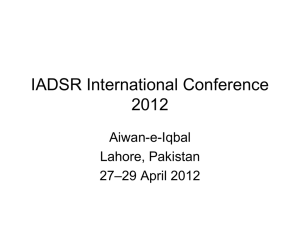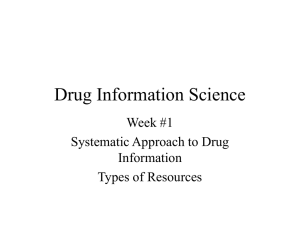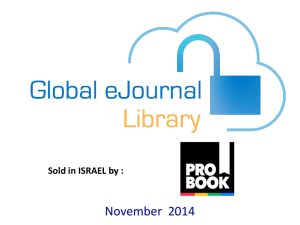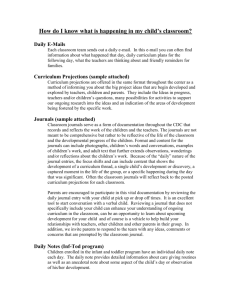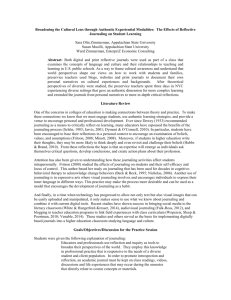Donnas Science Notebook Routine Thinking - Burlington
advertisement
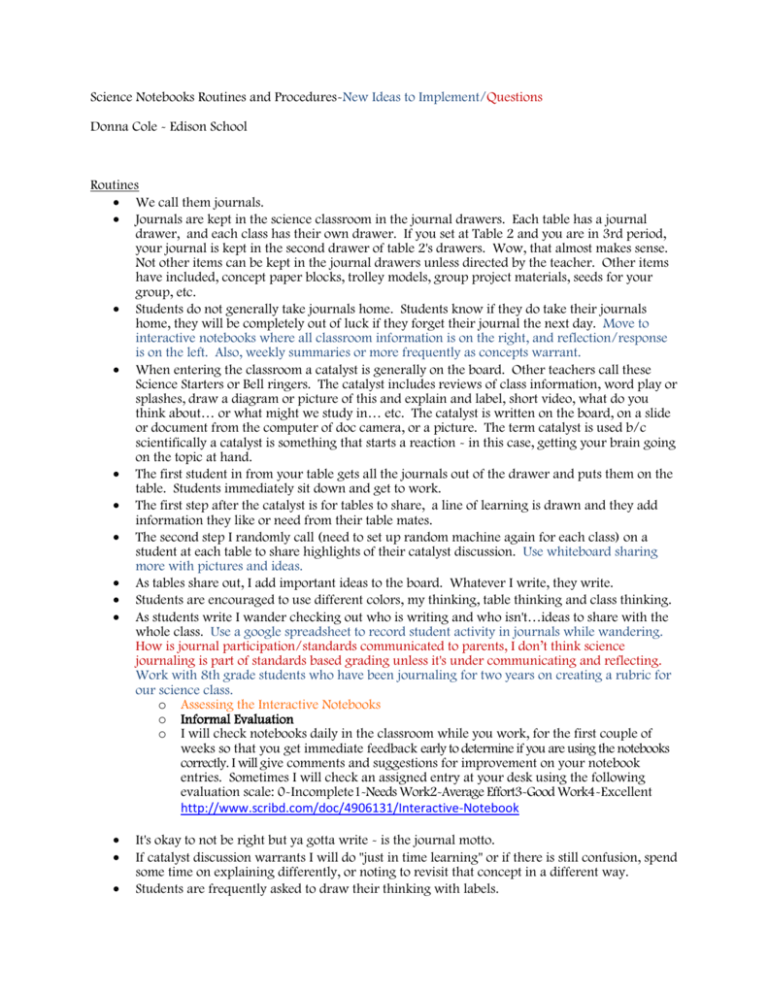
Science Notebooks Routines and Procedures-New Ideas to Implement/Questions Donna Cole - Edison School Routines We call them journals. Journals are kept in the science classroom in the journal drawers. Each table has a journal drawer, and each class has their own drawer. If you set at Table 2 and you are in 3rd period, your journal is kept in the second drawer of table 2's drawers. Wow, that almost makes sense. Not other items can be kept in the journal drawers unless directed by the teacher. Other items have included, concept paper blocks, trolley models, group project materials, seeds for your group, etc. Students do not generally take journals home. Students know if they do take their journals home, they will be completely out of luck if they forget their journal the next day. Move to interactive notebooks where all classroom information is on the right, and reflection/response is on the left. Also, weekly summaries or more frequently as concepts warrant. When entering the classroom a catalyst is generally on the board. Other teachers call these Science Starters or Bell ringers. The catalyst includes reviews of class information, word play or splashes, draw a diagram or picture of this and explain and label, short video, what do you think about… or what might we study in… etc. The catalyst is written on the board, on a slide or document from the computer of doc camera, or a picture. The term catalyst is used b/c scientifically a catalyst is something that starts a reaction - in this case, getting your brain going on the topic at hand. The first student in from your table gets all the journals out of the drawer and puts them on the table. Students immediately sit down and get to work. The first step after the catalyst is for tables to share, a line of learning is drawn and they add information they like or need from their table mates. The second step I randomly call (need to set up random machine again for each class) on a student at each table to share highlights of their catalyst discussion. Use whiteboard sharing more with pictures and ideas. As tables share out, I add important ideas to the board. Whatever I write, they write. Students are encouraged to use different colors, my thinking, table thinking and class thinking. As students write I wander checking out who is writing and who isn't…ideas to share with the whole class. Use a google spreadsheet to record student activity in journals while wandering. How is journal participation/standards communicated to parents, I don’t think science journaling is part of standards based grading unless it's under communicating and reflecting. Work with 8th grade students who have been journaling for two years on creating a rubric for our science class. o Assessing the Interactive Notebooks o Informal Evaluation o I will check notebooks daily in the classroom while you work, for the first couple of weeks so that you get immediate feedback early to determine if you are using the notebooks correctly. I will give comments and suggestions for improvement on your notebook entries. Sometimes I will check an assigned entry at your desk using the following evaluation scale: 0-Incomplete1-Needs Work2-Average Effort3-Good Work4-Excellent http://www.scribd.com/doc/4906131/Interactive-Notebook It's okay to not be right but ya gotta write - is the journal motto. If catalyst discussion warrants I will do "just in time learning" or if there is still confusion, spend some time on explaining differently, or noting to revisit that concept in a different way. Students are frequently asked to draw their thinking with labels. Catalyst may also be a form of KWL or write three questions that are bugging you. Or using science sentence stems. Use more sentence stems that are also used in writing conclusions. See Scientific Method Study Guide The PPT I use to introduce and review science notebooking each year is (hyperlink PPT here). This PPT is a conglomeration of various science notebooking sites as well as copies of my own former student scientific journaling. Ask Cathy Plesko and other former students for more examples of journaling. Students highlight or circle new vocabulary words. These were added to their science vocabulary index cards. This next year students will be able to use index cards or a flashcard system on their device. I haven't collected or "scored" notebooks other than assignments completed in the journals. The catalyst and enduring questions were at times the same thing. Students title and date each page of their journal. Students also developed ways to use stick 'ems in their journals to mark units or a formula page etc. Carianna Gischer posted a Facebook link on asking about experiences with Interactive Notebooks so I looked into IN's for about two hours. Here are the links I am saving to build my new Interactive Science Journal Expectations. http://www.southsanisd.net/webpages/breyna/resources.cfm http://msdouglasscience.wikispaces.com/SCIENCE+INTERACTIVE+NOTEBOOK https://sites.google.com/site/msfarris8thgradescienceclass/assignments/interactive-sciencenotebook http://sciencespot.net/Pages/starters.html http://middleschoolscience.com/starters.html http://sciencespot.net/Pages/ISNinfo.html http://www.middleschoolscience.com/notebook-2010-2011.htm These sites are a combination of catalyst possibilities/ideas and interactive notebook expectations, models and glue-ins. Based on looking into these links - here are some of the changes I'll be making and will be adding into my Science Journal PPT in random order: Go Interactive - the right page will be information from class, the right page will be for reflection, response, etc. Each right page for information will be in Cornell Note fashion - especially with the summary part. Look for AVID summary guidelines and ideas. I will be using a student built rubric to check journals periodically, specifically looking at their summaries. Students will also do a peer review of each other's journals using the rubric build by the 8th graders under guided direction from me. http://sciencespot.net/Pages/selfassessment.html Students will continue to write and reflect on enduring questions throughout the unit. But, will develop unit guides like the first link does showing students the enduring understandings, and enduring questions. I also want to incorporate the NGSS standard into this document. At the end of each unit, students will complete reflections as seen on the second link under NOS reflection. I am also hoping to build science portfolios. Each unit in the portfolio will show evidence of learning the enduring questions and understandings through scanning documents, pictures of hands-on learning and the reflection. This year I will try to have students create an index in the back of the journal at the end of the year. I plan to share this with the 8th graders and solve this process together. There will also be a vocabulary section. One of these links shows a word table to be spread out over a few pages. Students will write the words and then the page number the word is explained and discussed. Pages will be numbered this year. I will remind myself that this is the next phase in science notebooking and progress, not necessarily completed by the end of this school year, but a step in making journals more than what they are now.



